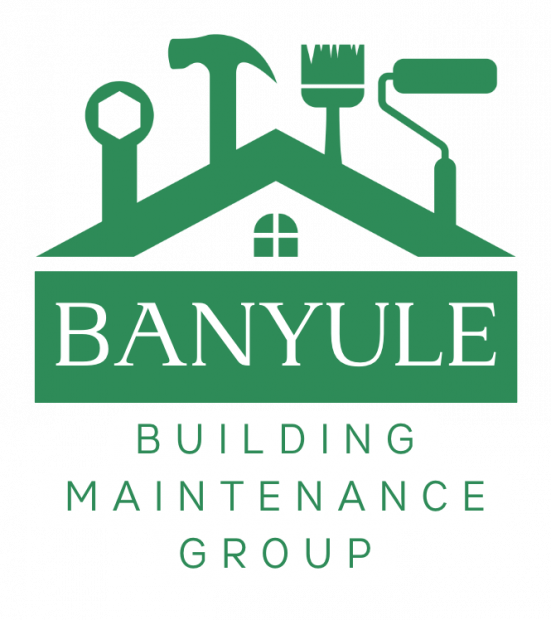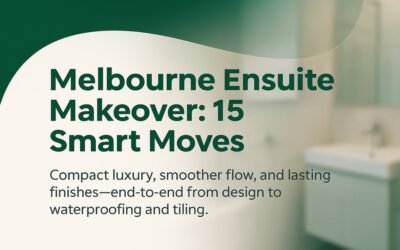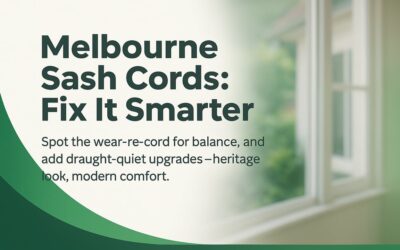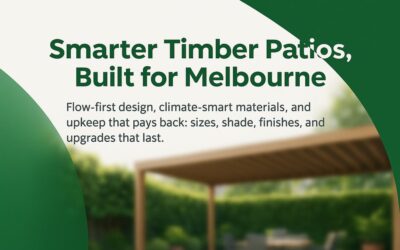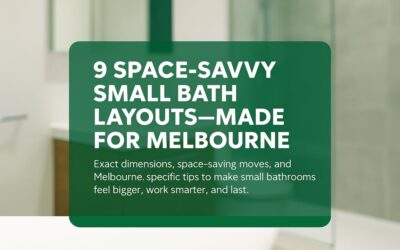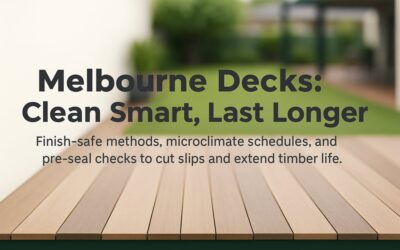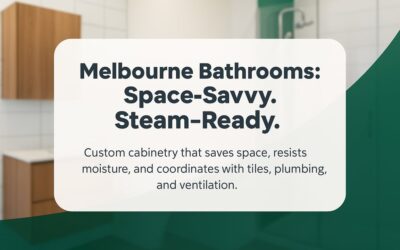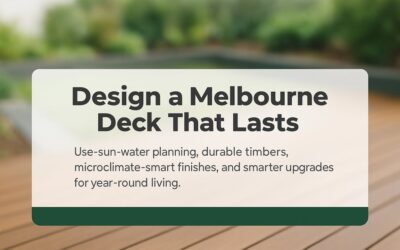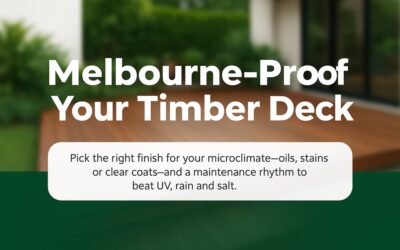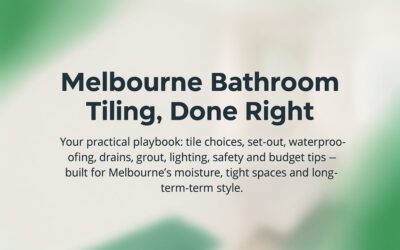BANYULE BUILDING MAINTENANCE GROUP
HELPFUL POSTS
Ensuite Renovations Melbourne: 15 Smart Moves For Compact Luxury, Better Flow, And Long-Term Durability
Melbourne ensuite renovations guide to 15 design-first moves for compact luxury, better flow and long-term durability, plus end-to-end service options to coordinate design, waterproofing, tiling and finishing.
Planning and priorities
– Layout first: door swings, toilet clearances, and 800 mm paths; avoid swing into the toilet zone.
– Map services early and account for timber subfloors, approvals, and acoustic needs.
– Ventilation is essential: externally ducted fan sized to room, with timer or humidity sensor.
Space optimization
– Wall-hung fixtures; frameless screens to extend sightlines.
– Large-format porcelain to reduce grout; mirrors with recessed storage for depth and light.
Shower-first detailing
– Target 900–1000 mm square internal space; prefer level-entry with linear drains.
– Continuous waterproofing and planned falls; niches away from direct water; slip-resistant tiles.
Storage and moisture-ready build
– Narrow vanities (400–430 mm) to maintain circulation; tall slim towers; inside-cabinet outlets.
– Porcelain, MR substrates, engineered stone, and solid-brass tapware for durability.
Tiling, lighting, and comfort
– Plan tile set-out; align joints; use movement joints; epoxy grout in showers.
– Layered lighting; 3000–3500 K; include optional under-tile heating.
Melbourne specifics
– Timber vs slab, inner-terrace access, apartment approvals, coastal corrosion considerations.
Budget and sequencing
– Keep plumbing in one zone; one hero surface; standard widths with tailored depths; staged upgrades.
– Sequence steps to prevent rework from measurements to commissioning.
Common mistakes to avoid
Mini checklists
– Compact Ensuite
– Master Ensuite with Luxe Touches
– Future-Friendly Upgrade
FAQs (questions only)
– What is a realistic budget range for an ensuite renovation in Melbourne?
– Can a small ensuite include both a shower and generous storage?
– Are large-format tiles suitable for tiny ensuites?
– What matters most for long-term durability?
– When is a level-entry shower worth it?
Quick self-review before you commit
– External venting, falls, tile set-out, wall fixings, and drawer-based storage plans.
Disclaimer: general information; seek professional assessment and quotes.
Sash Cord Replacement Melbourne: Practical Signals, Smarter Fixes, and Comfort Gains for Period Windows
The guide explains diagnosing sash cord wear, what a professional replacement involves, how Melbourne conditions affect cord life, comfort upgrades, and when to repair versus replace. Signs of wear include uneven weight or slamming, sash creeping, frayed cords near pulleys, rattles or gaps, and paint marks on tracks; root causes include sharp pulley edges, tight channels, paint buildup, and misaligned sashes. A professional replacement covers safe disassembly, weight access and balance checks, new hard-wearing cords with proper knots, pulley refurbishment, alignment and travel checks, low-friction beads and seals, glazing/putty touch-ups, and finish testing. In Melbourne, discreet improvements help preserve heritage while boosting comfort. Cord life is shortened by west/north sun, damp cycles, coastal salt, and urban dust; combine new cords with track cleaning and pulley refresh. Comfort upgrades include draught seals, laminated or secondary glazing, better airtightness, and reinforced latches. Repair vs replacement: re-cord when frames are sound; replacement when rot, distortion, recurring water ingress, or unmet energy goals exist. Costs depend on extent, access, finish, and add-ons; simple jobs are typically one day per opening; complex, multi-sash projects take longer. Maintenance rhythm: seasonal checks and cleaning to maintain travel and seals. Related service: sash cord replacement Melbourne with sealing and alignment. FAQs:
– Should both cords be replaced if only one has snapped?
– Will new cords make the window easier to lift and safer to use?
– Are modern cords suitable for heritage windows?
– How can noise and draughts be reduced during a re-cord job?
– What shortens cord life in Melbourne conditions?
Disclaimer: general guidance; seek qualified assessment.
Timber Patio Melbourne: Smarter Design Moves, Climate-Savvy Materials, and Upkeep That Pays You Back
Timber Patio Melbourne guides confident decisions for smarter design, climate-ready materials, and upkeep that adds lasting value. Key ideas cover:
– Design that works in real homes: prioritize circulation (min 900 mm around furniture; 800 mm in tight spaces with softened edges), separate zones (cook vs dining by ~1200 mm), shade strategy for west/north exposures, flush door transitions, and space-saving touches like built-in benches and planter edges.
– Material choices for Melbourne: select timber species (Merbau, Spotted Gum, Blackbutt, Ironbark) with appropriate fixings (316 stainless where needed), ensure ventilated substructures and proper wall flashing, and choose certified, sustainable timber.
– Cover, light, and comfort: combine solid roofs with slatted elements for airflow, address glare and privacy, and layer warm lighting for night use.
– Melbourne microclimate playbook: adapt to west/north exposure, leafy sites, coastal salt, and poolside conditions with suitable finishes and maintenance cycles.
– Finish systems and maintenance: penetrating oils, water-based semi-transparent stains, and film-build finishes; match maintenance to exposure and use.
– Drainage, safety, and compliance: ensure proper falls, consistent stairs, grip, lighting, and compliant balustrades.
– High-value upgrades: built-in seating, planter privacy, service-ready prep for heaters/lighting, and practical threshold lighting.
– Maintenance rhythm: seasonal checks and care windows to extend life.
– Cost-savvy planning: build core structure first, stage enhancements later, and invest in durable fixings and finishes.
FAQs
– What size suits a family-friendly dining zone?
– Which finish performs best on a west-facing patio?
– Can a weathered deck be turned into a covered patio?
– Do sustainably sourced timbers hold up in Melbourne?
– How frequently should finishes be refreshed?
Bathroom Renovation Cost Melbourne: A Plain-English Playbook To Plan Scope, Priorities, And Value In Real Homes
Melbourne bathroom renovation costs fall into three bands: refresh/budget upgrades; mid-range full renovation; and premium/bespoke redesign. A measured site assessment is essential before committing numbers or timelines.
What drives cost
– Scope of demolition and rebuild
– Plumbing relocations
– Waterproofing and substrate prep
– Tiling complexity and layout
– Fixtures, fittings, and warranties
– Custom cabinetry and benchtops
– Ventilation and electrical upgrades
– Access/logistics and waste management
– Compliance and inspections
Melbourne-specific considerations
– Mixed substrates (timber vs slab) and buildup heights
– Inner-terrace constraints and light preservation
– Apartments/strata requirements and slab penetrations
– Bayside humidity and corrosion resistance
Smart ways to save without sacrificing quality
– Plan layout first; lock clearances early
– Keep plumbing in one zone
– Use one hero material
– Prefer drawers over doors
– Prioritize ventilation and robust waterproofing
Sequence that keeps projects on track
– Measure, map services, note door swings
– Confirm scope and fixture moves
– Choose key finishes early
– Detailed set-out (drain, grid, cuts)
– Strip-out, prep substrates
– Waterproofing and dry time
– Tiling, falls to drains, grouting
– Cabinetry, benchtop, and fit-off
– Commissioning, cleaning, handover
Common mistakes that add cost later
– Underestimating membrane/fall needs
– Tile planning after set-out
– Unplanned waste removal in slab
– Skipping external fan ducting
– Unsealed penetrations in joinery
Mini checklists
– Compact Ensuite: narrow path, wall-hung vanity, single feature tile, frameless glass, linear drain
– Main Family Bathroom: storage first, slip-resistant tile, quiet externally ducted fan
– Future-Friendly Upgrade: level-entry shower, wall noggins for grab rails, wider clearances
Budget guardrails
– Spend: waterproofing, ventilation, prep/set-out, durable behind-wall components, moisture-resistant joinery
– Save: keep services in place, limited tile varieties, standard vanity widths, a single hero surface
FAQs
– What is a realistic budget range for a bathroom in Melbourne?
– What adds the most to cost?
– Can a small bathroom include both bath and shower?
– How can maintenance costs be reduced long term?
End-to-end team advantage and disclaimer
– A managed team reduces clashes and protects warranties; always obtain a professional assessment and written quote tailored to your project.
Window Frame Repair Melbourne: How To Spot Problems Early, Choose The Right Fix, And Keep Character And Comfort
Window frame repair in Melbourne focuses on managing water, air, security, noise, and heat to protect walls, preserve heritage character, and maintain comfort without unnecessary replacements. Early signs include water ingress and decay, movement and misalignment, seal/finish fatigue, and hardware wear.
Melbourne microclimates shape framing needs: west/north exposure accelerates coating fade and joint shrinkage; shaded areas retain moisture; coastal areas increase salt exposure; urban areas bring dust and noise through gaps.
Repair pathways range from minimal to deeper work: control moisture, local timber repairs, realign frames, restore operation (ropes, hinges, stays), refresh glazing interfaces, and apply durable coatings. When to repair vs replace: repair for localized decay and preserved profiles; partial renewal for deeper damage; full replacement for extensive rot, structural issues, or major energy/safety upgrades.
To boost comfort and efficiency: continuous perimeter seals, better glazing options (Low-E, laminated, or secondary glazing for heritage), and effective shading and condensation control with airtight installation.
Common mistakes to avoid: painting damp timber, sealing leaks without proper flashing, using incompatible sealants, over-tightening hardware, and blocking weep holes.
Seasonal inspection rhythm: late winter check drainage and soft spots; spring refresh seals; summer clean and test operation; autumn clear leaves and verify weep paths.
Cost drivers: extent of decay, access height, glass specification changes, finish/heritage matching, and number of frames.
Mini checklists: Period Timber Sash (balances, beads/seals, sills, putty, prime); Aluminium/uPVC (gaskets, drainage, rollers); Moisture hotspots (staining, flashing, irrigation).
FAQ questions:
– What are early signs a window frame needs repair?
– Will frame repair make rooms warmer and quieter?
– Can heritage proportions be preserved during repairs?
– How long do repaired frames last?
– When is full replacement the better option?
Small Bathroom Layout Melbourne: 9 Space-Savvy Plans That Feel Bigger, Work Smarter, and Last
Melbourne small-bathroom guide: 9 layouts, practical dimensions, and durable finishes to make tight rooms feel larger and work smarter.
Nine layouts: Single-Wall Straight Run; Galley Two-Wall; L-Shape Corner; Compact Wet Room; Niche Shower With Inline Vanity; Corner Entry Shower + Wall-Hung Toilet; Three-Wall Luxe; Bath-Shower Combo; Laundry-Combo Ensuite.
Key approach: measure room, map services, maintain circulation (800 mm; 700 mm in tight spaces); plan layout first.
Dimensions: toilet 750 mm clearance (600 mm front); shower 900×900 (1000×1000 ideal); vanity 400–430 mm; door clearance 100 mm.
Space-saving moves: wall-hung fixtures; large-format tiles; continuous floors; frameless glass; layered lighting.
Moisture/durability: waterproof membranes; external ventilation; slip-resistant floors; sealed joints.
Melbourne tips: timber subfloors ease waste relocation; slabs require care; inner-terrace pinch points; apartments need strata early.
Fixture/finish: slim basins; recessed niches; durable tops; matte tiles.
Budget pointers: keep plumbing in one zone; feature tile; standard vanity.
Professional help: coordinated teams align layout, waterproofing, cabinetry, and tiling.
FAQ questions:
– What is a realistic budget range for a small bathroom in Melbourne?
– Is a separate bath and shower realistic in a small room?
– Which layout suits a narrow terrace bathroom?
– Do large-format tiles work in small bathrooms?
– How important is ventilation in small bathrooms?
Deck Cleaning Melbourne: Safe Methods, Local Microclimates, and a Practical Upkeep Rhythm
Melbourne decks endure strong UV, winter rain, and bayside salt. Proper cleaning extends timber life, improves coating adhesion, and reduces slips. This guide covers safe, finish-friendly cleaning, climate-based maintenance rhythms, and what to do before resealing or staining.
What deck cleaning actually does
– Removes grime, mould, and algae to reduce moisture traps and slipperiness.
– Lifts tannin bleed and metal stains to restore a fresher timber look.
– Prepares the surface for even, longer-lasting finishes.
Finish-friendly cleaning methods
– Dry prep: sweep thoroughly and clear leaf traps to avoid damp pockets.
– Wet cleaning sequence: light pre-wet, apply timber-safe cleaner, dwell, agitate with a soft/medium brush, rinse along the grain. Avoid high-pressure blasting; if used, employ a fan tip, low pressure, and wide distance.
– Targeted treatments: oxygen-based cleaners for mould/algae, detannin solutions for bleed, oxalic-based brighteners for rust stains.
Melbourne microclimates and cleaning frequency
– West/north-facing: high UV; quarterly light cleans during peak sun.
– Shaded/tree-heavy: more moisture; clean every 6–8 weeks in wet seasons.
– Bayside/coastal: salt spray; rinse monthly and clean seasonally.
– Poolside: monthly light cleans in summer; check for slippery algae.
Pre-seal checklist after cleaning
– Timber dry to touch; conditions suitable for curing.
– Defects corrected; loose boards/soft spots fixed.
– Detannin treatments complete; dust removed; end grain clean.
Common mistakes to avoid
– Over-pressuring, incompatible chemical mixes, skipping rinses, coating in damp weather, neglecting ventilation.
Safe traction and family use
– Prioritize drainage; avoid slick finishes on wet paths; use entry mats.
What to clean with across common timbers
– Merbau: gentle wash; detannin as needed; rinse well.
– Spotted Gum: timber-safe cleaner; oxalic brightener for rust; low-pressure rinse.
– Blackbutt: even agitation; avoid streaks and lap marks.
Seasonal upkeep rhythm
– Late winter: inspect drainage and soft spots.
– Spring: deeper clean; detannin as needed; prep for finishing.
– Summer: light cleans for dust and spills.
– Autumn: sweep to reduce leaf tannins; clear debris.
When to pair cleaning with other work
– Recurring black marks at fixings: consider stainless steel upgrades.
– Cupping/splinters after over-washing: repairs or replacement may be needed.
– Uneven finish wear: plan full prep and recoat after cleaning.
FAQs (questions only)
– Is pressure washing safe for timber decks?
– What is the best time of year to clean a Melbourne deck?
– Will cleaning remove grey weathering?
– How often should a deck be cleaned?
– Do eco-friendly cleaners actually work?
Disclaimer: a professional assessment is recommended before significant repairs or coatings.
Window Installation Melbourne: Smart Choices For Comfort, Character, And Lower Bills
Melbourne window installation guide focusing on comfort, efficiency, and curb appeal through frame choice, glazing, and installation method. It outlines materials, glass options, microclimates, retrofit vs full-frame, operation styles, leak prevention, cost drivers, and planning.
– Frame materials: timber (period feel and repairability), aluminium (slim, durable, coastal-ready), and uPVC (thermally efficient, low maintenance).
– Glass options: Low-E coatings, double glazing, laminated/interlayers, tints, and safety glass.
– Local climate tailoring: address west/north sun, damp zones, and bayside salt with appropriate hardware and glass choices.
– Installation approach: retrofit inserts vs full-frame replacements.
– Window types: sash, awning, casement, sliding, and fixed units.
– Leak and draft prevention: accurate sizing, proper flashings, continuous seals, correct fixings, and appropriate finishes.
– Cost considerations: frame material and profile, glass specification, installation type, finishing, and any heritage or custom work.
– Period vs modern homes: preserve proportions and glazing bars for heritage while adopting slimmer frames and larger panes for contemporary looks.
– Condensation and ventilation: reduce by using Low-E/double glazing, airtight installation, and controlled indoor humidity.
– Planning checklist: define goals, map microclimate, choose frame and glass, decide retrofit or full-frame, confirm compliance, plan finishes.
FAQs
– What is the difference between retrofit and full-frame installation?
– Will new windows make a home warmer and quieter?
– Which windows suit heritage facades?
– How is condensation reduced in winter?
– What affects window installation cost the most?
Custom Bathroom Cabinetry Melbourne: Space-Savvy, Moisture-Smart Ideas That Make Real Bathrooms Work
Custom bathroom cabinetry in Melbourne emphasizes space-saving, moisture-smart joinery coordinated with tiling, plumbing and ventilation to improve safety, efficiency and value.
Key ideas
– Layout: right-depth vanities and slim towers to keep clear paths; drawers at waist height; mirrors at eye level; integrated shadow lines.
– Smart storage by room type: terrace/narrow—shallow vanities (400–430 mm), recessed shaving cabinets, sliding doors; family—double-drawer stacks, tall linen towers, integrated hampers; ensuite—wall-hung vanities to free floor space, corner towers, under-sink drawers.
– Moisture-smart construction: moisture-resistant carcasses with sealed edges; durable faces (laminates, 2-pack, or HPL); benchtops in porcelain/sintered/engineered stone; corrosion-resistant hardware; seal penetrations.
– Coordination with tiles/plumbing: align benchtop/cabinet lines with grout; plan for power inside cabinets; ensure door swings don’t clash with fittings.
– Ergonomics: bench heights ~850–900 mm; drawers-first storage; mirror height ~1000–1100 mm; 800 mm clear path (700 mm possible with careful detailing).
– Ventilation and longevity: externally ducted fans; continuous waterproofing membranes; silicone at interfaces; kickspace to limit splash.
– Design trends: warm wood tones with moisture-friendly finishes; integrated handles; frameless mirrors with storage; open cubbies away from splash zones.
– Budget levers: limit plumbing reruns; single hero finish with simple carcass; standard widths with depth tweaks; plan service voids for future upgrades.
– When to choose custom: tricky rooms, high storage needs, tile/hardware alignment, longevity.
FAQs
– What cabinet depth suits a narrow Melbourne bathroom?
– Are wall-hung vanities durable?
– Which finishes are easiest to maintain?
– Can drawers work with existing plumbing?
Sash Window Restoration Melbourne: Practical Ways To Keep Character, Cut Draughts, And Boost Comfort
Melbourne sash window restoration guide explaining how sash windows work, common climate-related problems, and practical steps to restore while preserving character and improving comfort and energy efficiency. It covers diagnosing issues (moisture cycles, UV damage, salt/urban grime, condensation, wear of cords and hardware), and a restoration sequence: first address moisture to stop ongoing damage; timber repair and consolidation (splice repairs, epoxy consolidation); restore operation with new cords and balanced hardware; renew beads, seals, and glazing putty; reglaze with appropriate compounds; and finish with durable coatings. Comfort upgrades include draught-proofing, secondary glazing, retrofit glazing where possible, and shading strategies, all balanced to respect heritage profiles. The guide also weighs options: local repair, partial renewal, or full replacement, and provides Melbourne-specific microclimate tips. It outlines a maintenance rhythm across late winter, spring, summer, and autumn, and flags cost drivers like extent of decay, access, glass spec, coatings, and number of sashes. It notes that professional help aids complex repairs, heritage compliance, and minimizing disruption. A disclaimer cautions that site conditions vary and professional assessment is advisable.
FAQ (questions):
– What are common signs that a sash window needs restoration?
– Will restoration make rooms warmer and quieter?
– Can original profiles be preserved?
– How long do restored sash windows last?
– Is full replacement ever unavoidable?
Custom Deck Design Melbourne: Practical Ideas, Microclimate Choices, and Smarter Upgrades for Long-Lasting Outdoor Living
Custom Deck Design Melbourne offers practical, design-first guidance for durable outdoor living in Melbourne’s climate. It starts with Use, Sun, and Water—planning for access, grilling zones, shading, and reliable drainage. Design moves add everyday value through natural zones, built-in seating, planters, step lighting, flush door thresholds, and discreet storage.
Smart material choices favor responsibly sourced timber (Merbau, Spotted Gum, Blackbutt, Ironbark) with ventilated framing, stainless fixings, and proper flashing. Finish systems should suit microclimates: penetrating oils, water-based stains, or film-build clears, with coastal or pool considerations.
Safety, compliance, and comfort cover slip resistance, balustrade rules, thermal shading, and acoustic privacy. Longevity hinges on ledger protection, airflow, moisture control, end-grain sealing, and proper drainage. Budget levers prioritize standard spans with premium fixings, staged builds, and consistent finishes. Seasonal care maps late winter checks, spring coatings, summer cleaning, and autumn debris management. Professional help adds value for complex sites and coordinated trades. Quick planning checklist: intended uses, sun/shade/wind mapping, water management, timber and fixings, finish choice, thresholds/lighting, and service provisions. FAQs: What size should an outdoor dining zone be? Which finish lasts best on a west-facing deck? Can a weathered deck be restored? Are sustainably sourced timber patios practical in Melbourne? What makes a deck safer around pools?
Bathroom Vanity Installation Melbourne: A Homeowner’s Playbook for Smarter Layouts, Lasting Materials, and Leak-Free Finishes
Melbourne bathroom vanity installation guide for smarter layouts, lasting materials, and leak-free finishes. A vanity upgrade affects traffic flow, storage, cleaning, moisture control, and design coherence, with a Melbourne-focused path from design through tiling and finishing.
Key ideas: vanities set circulation width, mirror height, and task lighting; drawers reduce bending; wall-hung vanities create space and ease cleaning, but require solid fixing and wall services.
Step 1: measure and decide freestanding vs wall-hung.
– Target at least an 800 mm clear path; in tight spaces, 700 mm can work.
– Benchtop heights: 850–900 mm; vessel tops around 820–850 mm.
– Freestanding suits timber subfloors; wall-hung needs accurate fixing and services planning.
Step 2: Plumbing orientation and Melbourne subfloor realities.
– Timber subfloors: easier to adjust if access exists below.
– Concrete slabs: moving wastes may require cuts; keep waste near existing services to control cost.
– Apartments: stacks and acoustics may limit relocation; consider wall mixers or hob-mounted taps to reduce penetrations.
Step 3: Materials that survive moisture and time.
– Benchtops: porcelain or sintered stone; engineered stone is reliable; timber tops require sealing and splash control.
– Cabinetry: moisture-resistant substrate with sealed edges; durable laminates or 2-pack finishes.
– Hardware: soft-close, quality runners and hinges.
– Basins: porcelain or solid surface; under-mount for clean lines with precise sealing.
Step 4: Waterproofing and tiling sequence.
– Substrate prep, membranes with proper upturns, align tile set-out with vanity, seal all junctions with silicone.
Step 5: Ventilation and lighting.
– Externally ducted extraction; task lighting 3000–3500 K; low-level night lighting.
FAQs
– What vanity width works best in a compact ensuite?
– Is wall-hung harder to install than freestanding?
– How can water damage around the vanity be reduced?
– What lighting should be planned around the vanity?
Deck Sealing Melbourne: A Microclimate-Savvy Guide To Longer-Lasting Timber Decks
Melbourne decks face harsh sun, wet winters, and coastal salt, so sealing choices, prep, and a steady maintenance rhythm extend life without overdoing upkeep. Sealing slows greying, controls moisture, eases cleaning, and supports fastener longevity near pools or bayside.
Finish types:
– Penetrating oils: natural look, easy refresh, best in damp/shaded areas; more frequent top-ups on west/north.
– Water-based semi-transparent stains: UV protection with tint; quick dry; even technique required to avoid lap marks.
– Film-build varnishes/2K clears: high sheen and UV protection; best with disciplined prep and stable boards.
Microclimates guide choices and rhythm: West/north faces UV/heat; choose UV-tinted stain or premium oil; inspect at 6 months, top-up 6–12 mo. Shaded areas: breathable oils; quarterly clean, recoat 12–18 mo. Bayside: salt exposure; UV-stable stain; rinse monthly, recoat 9–12 mo. Poolside: chlorine/wet; high-traction finishes; clean monthly in summer, recoat 9–15 mo.
Prep steps: assess/repair; gentle clean; detannin; ensure dryness; mask and stage.
Application cues: board-by-board, end-grain sealing, proper coat thickness, cure windows.
Maintenance rhythm: quarterly sweep/rinse; seasonal light cleans; annual fixings check; recoats vary by aspect.
Common mistakes: trapped moisture; over-pressured cleaning; mismatched finishes; ignoring substructure.
Professional help: consider for complex substrates or to secure a warranty.
FAQ questions:
– Is sealing different from staining?
– How often should a Melbourne deck be resealed?
– Can a worn deck be sealed without sanding?
– Which timbers respond best to sealing in Melbourne?
– Does sealing make a deck slippery?
Timber Window Repairs Melbourne: A Homeowner’s Field Guide to Keep Character, Cut Draughts, and Extend Window Life
Melbourne Timber Window Repairs: field guide for homeowners to keep character, reduce draughts, and extend life. Explains real-world causes of timber window problems, triage, sensitive repair options, and upgrades that respect heritage while boosting comfort and efficiency.
Causes of failure: moisture cycling (winter rain, coastal air), UV exposure (summer sun on exposed faces), movement and age (seasonal expansion/contraction, worn cords/pulleys), and condensation from poor ventilation.
Fast diagnosis—typical symptoms: sticky or jammed sashes; draughts around frames; flaking paint with soft patches; foggy panes or rattling glass; water stains on sills.
Repair pathways that preserve character: localised decay treatment (isolate cause, cut back to sound wood, splice or consolidate); sash mechanics and balance (re-rope or replace cords, true alignment, new beads with seals); reglazing and weatherproofing (renew putty, proper glazing compounds, safety/laminated glazing where needed, exterior paint system).
Efficiency upgrades without losing heritage: discreet weather seals; secondary glazing; retrofit glazing (where suitable); shading via external features or planting.
When to repair vs replace: repair for localised decay and operable sashes; partial renewal when lower rails are damaged; replacement for extensive frame decay, safety concerns, or when efficiency targets demand it.
Melbourne microclimate tips: coastal bayside—quality hardware and UV/salt-resistant coatings; leafy areas—breathable, well-primed finishes; west/north high-UV—short repaint cycles and possible Low-E glazing.
Maintenance rhythm: annual winter checks; spring touch-ups and hardware service; summer UV monitoring; autumn drainage and paint touch-ups.
Cost drivers: decay extent, access, glass specification, finish complexity.
Quick buyer’s checklist: scope clarity; address moisture sources; balance and operation; aftercare and maintenance plan.
FAQ questions (no answers):
– What are common signs that a timber window needs professional attention?
– Can original sash proportions be preserved while improving comfort?
– How long do repairs last?
– Is full replacement ever unavoidable?
Pro tip: Coatings protect; they do not fix structural decay or water entry. Disclaimer: general guidance; site-specific assessment and professional advice are essential.
Bathroom Tiling Melbourne: A Practical Playbook For Beautiful, Durable Renovations
Melbourne bathrooms require handling mixed timber/concrete subfloors, local moisture, and tight layouts. The guide covers durable tile choices (porcelain for floors/showers; ceramic for walls; natural stone with sealing; large-format slabs needing flat substrates), strategic set-out (hero sightlines, balanced cuts, aligned grout with fixtures, careful falls), and practical sequencing of substrates, waterproofing, and movement joints. Drainage options include linear or point drains and level-entry considerations. Grout and sealants balance long-term maintenance (epoxy grout in wet zones; cementitious elsewhere; silicone joints; appropriate joint widths). Layout patterns work in real homes: grid/stacked for precision, brick for forgiving alignment, herringbone/chevron as a controlled feature, vertical stacks to heighten ceilings. Ventilation, lighting, and cleaning are prioritized with exterior exhaust, layered lighting, and easy-clean surfaces. Budget tips focus on keeping plumbing positions, using one premium feature tile with durable field tiles, strategic epoxy use, and smart thresholds. Safety and future-proofing emphasize slip resistance, under-tile heating, and discreet noggins for future grab rails. Mini checklists cover Compact Ensuite, Main Family Bathroom, and Future-Friendly Upgrades. FAQs:
– What tile size works best in a small bathroom?
– Is glossy or matt better for walls?
– How do movement joints affect the look?
– Can grout discolor be prevented?
